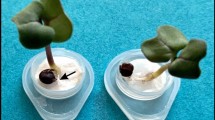Abstract
Infectivity of resting spores ofPolymyxa betae in soil stored air-dry or moist was determined by assessing infection of bait plants that were exposed to the soil. Storage of soil under air-dry conditions at room temperature resulted in a delayed onset of germination of resting spores compared to germination in soil stored under moist and cool conditions, as inferred from the infection of the bait plants. Bait plants had to be exposed for more than 12 h to flooded infested soil before germination and infection had occurred. However, when soil was prewetted for 24 h before exposing bait plants, germination, infection and transmission of beet necrotic yellow vein virus (BNYVV) were accomplished within 12 h, but only with the moistly stored soil. When resting spores isolated from roots were stored for 4 and 8 weeks under dry conditions at 22°C, germination of viruliferous spores, as measured by detection of BNYVV in bait plants exposed for 48 h to the spores, was less than that of spores stored in moist soil at 22°C. Approximately 100% of bait plants were infected after exposure to resting spores that were frozen in demineralized water or stored cool (5°C) in water or moist soil for 42 weeks. Air-dry cool storage for 42 weeks resulted in a low percentage of infection. Storage conditions of soil influence the results of bioassays for detection of rhizomania when short baiting periods are applied, whereas differences in infectivity were not detected using a bioassay with long duration.
Similar content being viewed by others
References
Abe, H. & Tamada, T., 1986. Association of beet necrotic yellow vein virus with isolates ofPolymyxa betae Keskin. Annals of the Phytopathological Society of Japan 52: 235–247.
Beemster, A.B.R. & De Heij, A., 1987. A method for detectingPolymyxa betae and beet necrotic yellow vein virus in soil using sugar-beet as a bait plant. Netherlands Journal of Plant Pathology 93: 91–93.
Bouhot, D., 1988. Early stage detection ofPolymyxa betae on sugar beet roots as a method for soil diagnosis pesticides studies and screening of new genotypes. In: Abstracts of Papers, Fifth International Congress of Plant Pathology. Kyoto, Japan, August 1988. p. 453.
Campbell, R.N. & Lin, M.T., 1976. Morphology and thermal death point ofOlpidium brassicae. American Journal of Botany 63:826–832.
Fujisawa, I. & Sugimoto, T., 1977. Transmission of beet necrotic yellow vein virus byPolymyxa betae. Annals of the Phytopathological Society of Japan 43: 583–586.
Habibi, B., 1969. Beiträge zur Biologie vonPolymyxa betae. Dissertation, Göttingen. 83 pp.
Hawker, L.E. & Madelin, M.F., 1976. The dormant spore. In: Weber, D.J. & Hess, W.M. (Eds), The fungal spore: form and function. Wiley, New York. p. 1–70.
Ivanović, M., MacFarlane, I. & Woods, R.D., 1983. Viruses of sugar beet associated withPolymyxa betae. In: Report of the Rothamsted Experimental Station, 1982. p. 189–190.
Keskin, B., 1964.Polymyxa betae n.sp., ein Parasit in den Wurzeln vonBeta vulgaris Tournefort, besonders während der Jugendentwicklung der Zuckerrübe. Archiv für Mikrobiologie 49: 348–374.
Payne, R.W., Lane, P.W., Ainsey, A.E., Bicknell, K.E., Digby, P.G.N., Harding, S.A., Leech, P.K., Simpson, H.R., Todd, A.D., Verrier, P.J., White, R.P., Gower, J.C., Tunnicliffe Wilson, G. & Paterson, L.J., 1988. Genstat 5 Reference Manual. Clarendon Press, Oxford. 749 pp.
Peters, D. & Godfrey-Veltman, A., 1989.Polymyxa betae zoospores as vectors of beet necrotic yellow vein furovirus. EPPO Bulletin 19: 509–515.
Slykhuis, J.T., 1974. Differentiation of transmission and incubation temperatures for wheat spindle streak mosaic virus. Phytopathology 64: 554–557.
Slykhuis, J.T., 1975. Effects of drying on the transmissibility of wheat spindle streak mosaic virus in soils from wheat fields in Ontario. Canadian Plant Disease Survey 55: 106–108.
Somerville, W., 1894. An infection experiment with finger and toe. Journal of the Royal Agricultural Society of England 5: 808–811.
Sussman, A.S., 1976. Activators of fungal spore germination. In: Weber, D.J. & Hess, W.M. (Eds), The fungal spore: form and function. Wiley, New York. p. 101–137.
Sussman, A.S. & Halvorson, H.O., 1966. Spores: their dormancy and germination. Harper & Row, New York, London. 354 pp.
Tuitert, G., 1990. Assessment of the inoculum potential ofPolymyxa betae and beet necrotic yellow vein virus (BNYVV) in soil using the most probable number method. Netherlands Journal of Plant Pathology 96: 331–341.
Tuitert, G. & Hofmeester, Y., 1992. Epidemiology of beet necrotic yellow vein virus in sugar beet at different initial inoculum levels in the presence or absence of irrigation: Dynamics of inoculum. Netherlands Journal of Plant Pathology 98: 343–360.
Usugi, T., 1988. Epidemiology and management in Japan of soil-borne cereal mosaic viruses with filamentous particles. In: Cooper, J.I. & Asher, M.J.C. (Eds), Developments in applied biology II. Viruses with fungal vectors. Association of Applied Biologists, Wellesbourne, UK. p. 213–225.
Westerlund, F.V., Campbell, R.N., Grogan, R.G. & Duniway, J.M., 1978. Soil factors affecting the reproduction and survival ofOlpidium brassicae and its transmission of big vein agent to lettuce. Phytopathology 68: 927–935.
Author information
Authors and Affiliations
Rights and permissions
About this article
Cite this article
Tuitert, G. Effect of conditions during storage of infested soil on infection of bait plants by Polymyxa betae and beet necrotic yellow vein virus. Netherlands Journal of Plant Pathology 99, 291–301 (1993). https://doi.org/10.1007/BF01974310
Accepted:
Issue Date:
DOI: https://doi.org/10.1007/BF01974310




